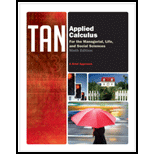Sorry! We don’t have solutions for this edition yet.
Solutions are available for other editions of this book
View 10th Edition solutionsarrow_forwardBook Details
Preface.
1. PRELIMINARIES.
Precalculus Review I. Precalculus Review II. The Cartesian Coordinate System. Straight Lines. Chapter 1 Summary of Principal Formulas and Terms. Chapter 1 Concept Review Questions. Chapter 1 Review Exercises. Chapter 1 Before Moving On.
2. FUNCTIONS, LIMITS, AND THE DERIVATIVE.
Functions and Their Graphs. The Algebra of Functions. Functions and Mathematical Models. Portfolio. Using Technology: Finding the Points of Intersection of Two Graphs and Modeling. Limits. Using Technology: Finding the Limit of a Function. One-Sided Limits and Continuity. Using Technology: Finding the Points of Discontinuity of a Function. The Derivative. Using Technology: Graphing a Function and Its Tangent Line. Chapter 2 Summary of Principal Formulas and Terms. Chapter 2 Concept Review Questions. Chapter 2 Review Exercises. Chapter 2 Before Moving On.
3. DIFFERENTIATION.
Basic Rules of Differentiation. Using Technology: Finding the Rate of Change of a Function. The Product and Quotient Rules. Using Technology: The Product and Quotient Rules. The Chain Rule. Using Technology: Finding the Derivative of a Composite Function. Marginal Functions in Economics. Higher-Order Derivatives. Using Technology: Finding the Second Derivative of a Function at a Given Point. Implicit Differentiation and Related Rates. Differentials. Using Technology: Finding the Differential of a Function. Chapter 3 Summary of Principal Formulas and Terms. Chapter 3 Concept Review Questions. Chapter 3 Review Exercises. Chapter 3 Before Moving On.
4. APPLICATIONS OF THE DERIVATIVE.
Applications of the First Derivative. Using Technology: Using the First Derivative to Analyze a Function. Applications of the Second Derivative. Using Technology: Finding the Inflection Points of a Function. Curve Sketching. Using Technology: Analyzing the Properties of a Optimization I. Using Technology: Finding the Absolute Extrema of a Function. Optimization II. Chapter 4 Summary of Principal Terms. Chapter 4 Concept Review Questions. Chapter 4 Review Exercises. Chapter 4 Before Moving On.
5. EXPONENTIAL AND LOGARITHMIC FUNCTIONS.
Exponential Functions. Using Technology. Logarithmic Functions. Compound Interest. Using Technology: Finding the Accumulated Amount of an Investment, the Effective Rate of Interest, and the Present Value of an Investment. Differentiation of Exponential Functions. Using Technology. Differentiation of Logarithmic Functions. Exponential Functions as Mathematical Models. Portfolio. Using Technology: Analyzing Mathematical Models. Chapter 5 Summary of Principal Formulas and Terms. Chapter 5 Concept Review Questions. Chapter 5 Review Exercises. Chapter 5 Before Moving On.
6. INTEGRATION.
Antiderivatives and the Rules of Integration. Integration by Substitution. Area and the Definite Integral. The Fundamental Theorem of Calculus. Portfolio. Using Technology: Evaluating Definite Integrals. Evaluating Definite Integrals. Using Technology: Evaluating Integrals for Piecewise-Defined Functions. Area between Two Curves. Using Technology: Finding the Area between Two Curves. Applications of the Definite Integral to Business and Economics. Using Technology: Business and Economic Applications/Technology Exercises. Chapter 6 Summary of Principal Formulas and Terms. Chapter 6 Concept Review Questions. Chapter 6 Review Exercises. Chapter 6 Before Moving On.
7. ADDITIONAL TOPICS IN INTEGRATION.
Integration by Parts. Integration Using Tables of Integrals. Numerical Integration. Improper Integrals. Applications of Calculus to Probability. Chapter 7 Summary of Principal Formulas and Terms. Chapter 7 Concept Review Questions. Chapter 7 Review Exercises. Chapter 7 Before Moving On.
8. CALCULUS OF SEVERAL VARIABLES.
Functions of Several Variables. Partial Derivatives. Portfolio. Using Technology: Finding Partial Derivatives at a Given Point. Maxima and Minima of Functions of Several Variables. The Method of Least Squares. Using Technology: Finding an Equation of Least-Squares Line. Constrained Maxima and Minima and the Method of Lagrange Multipliers. Double Integrals. Chapter 8 Summary of Principal Formulas and Terms. Chapter 8 Concept Review Questions. Chapter 8 Review Exercises. Chapter 8 Before Moving On.
Appendix A.
The Inverse of a Function. The Graphs of Inverse Functions. Functions That Have Inverses. Finding the Inverse of a Function.
Appendix B.
Indeterminant Forms and l'Hôpital's Rule. The Indeterminant Forms 0/0 and ?/ ?.
Index.
More Editions of This Book
Corresponding editions of this textbook are also available below:
